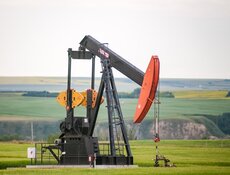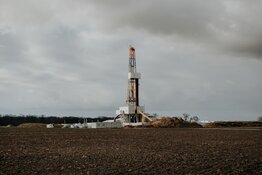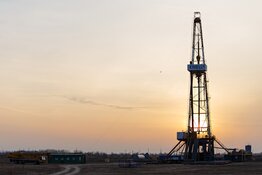Marshall Berol: Malcolm Gissen and I started Encompass Fund five years ago. We've been very ably assisted by Craig Valdes and Kevin Puil. Our concept was to invest globally in any market cap size company, utilizing both a top-down and bottom-up approach. That results in us looking at sectors we find to be attractive going forward, and then selecting companies within that segment that could experience long-term capital appreciation, which is the objective of the Encompass Fund. We also look at individual companies regardless of industry, where we like the company's fundamentals.
We have liked resource companies for the past decade. When we started Encompass Fund in 2006, we had already been invested on behalf of individual private client accounts in various sectors of the resources industries, including energy, primarily oil and gas. We have continued to be invested in those industries because they have had some excellent growth and we expect that to continue in the future. So, that's what led to the Encompass Fund performing very well in the last several years.
The end of 2008 is very painful to recall, as I'm sure it is for all of your readers. But, in late 2008 and the beginning of 2009, we eliminated some companies in the portfolio that we didn't feel were as strong as some of the others and added to the companies that we thought were particularly strong, but suffering from the general stock market problems. That led to a 137% gain for Encompass Fund in 2009 and a further 60% gain in 2010. For the trailing one-year and three-year periods, Encompass Fund ranks as the top International Mutual Fund, according to Morningstar.
TER: In reviewing your portfolio, nine of the 10 largest holdings are resource companies. Is that the approach you'll likely be following in the future?
MB: At this point, the outlook is bright for resource companies, including precious and base metals as well as oil, natural gas, coal and uranium. At some point in the future, one or more of these sectors will be less attractive for investment opportunities and we'll adjust accordingly.
TER: What is your current thinking on where the various energy areas are headed now, in light of the changes since our last interview here in May 2010?
Craig Valdes: We like natural gas as a commodity and as an energy supply. But, because of advanced technologies such as "fracking" and horizontal drilling, you've seen an abundance of supply. And so, we might not be as positive on the direction of the price, meaning that it's probably going to stay in the $4 to $5 Mcf. (thousand cubic feet) range in the near-term. But, as an energy component, we strongly believe that over the longer-term our energy policies will lean more toward natural gas.
Oil has backed off from its recent highs, but the oil price is really a function of how well the global economy is doing. As long as we have an environment with even slow to expanded growth in emerging economies, there's going to be a continued demand for energy. So, we like oil for the near and long term.
TER: Do you expect any sort of a stabilized price range for oil, or are we going to see big moves up and down?
CV: I think that has a lot to do with energy policy. It also has to do with global growth and the emerging growth economies. We believe that prices on the low end may trade somewhere in the $70-$80/barrel (bbl.) range and at the high end it could be as much as $100-$120/bbl. I think oil stays in a reasonable trading range over the near-term and the next couple of years. The only thing that could easily change that are the Saudis and the Middle East geopolitics, which could affect pricing and supply. We believe that pricing is not going to change that much over the next couple of years.
MB: Certainly, geopolitical issues will have a large bearing in the short-term. We take a nine- to 12-month view in any of these industries. Short-term you get a lot more volatility. For example, when it was announced they were going to release 60 Mbbl. of oil from strategic reserves around the world, including 30 Mbbl. from the U.S. strategic reserve, the WTI oil price went down about 10% from around $100-$90/bbl. Now it's back up to near $100/bbl. So, in the short-term it had some affect. In the long term it doesn't. Overall demand continues and overall supplies are basically tight. Some particular situations could lead to a larger decline or, more likely, a larger spike.
TER: Can you tell us about some oil and gas situations you particularly like at this time?
MB: One company that is a major holding in Encompass Fund and has been for some time, is a smaller low-priced stock, GeoPetro Resources Company (NYSE.A:GPR). GeoPetro has five different projects, any one of which could be a real company maker. We have participated in private placements with the company, as well as buying the stock in the open market. The company has an operating natural gas plant and some natural gas wells in Texas. It has a very interesting project in the San Joaquin Basin area in south-central California. It sold a couple of large land positions it held in Alaska to Linc Energy Ltd. (ASX: LNC; OTCQX: LNCGY) of Australia and retained an attractive royalty interest. It is also one-third partner in a project in Canada with PetroBakken Energy Ltd. (TSX:PBN). That is less likely to be acted upon in the near future, but it's got some very good promise.
GeoPetro has a minority interest in a project in Indonesia with the majority interest held by Chinese companies. The Chinese are actively doing seismic work and plan on drilling later this year. Any one of those projects with drilling success could be extremely beneficial for the company's stock. GeoPetro has contracted to sell some excess equipment this September that will bring in more than $9M. That would be used to increase production from the Madisonville, Texas, wells and improve the natural gas processing. Those improvements should take the company to at least a positive cash-flow situation, which would be very attractive also. It's a low-priced stock and there aren't hundreds of millions of shares outstanding, as you sometimes see.
TER: What else do you like?
CV: We're very bullish on the San Joaquin Basin in south-central California. NiMin Energy Corp. (TSX:NNN) is in the San Joaquin Basin. There are some big players down there like Occidental Petroleum Corp. (NYSE:OXY) with its huge find in 2009. NiMin is just a stone's-throw away from some of that production. It's heavy oil and NiMin has an enhanced oil recovery process called CMD, (Combustion Miscible Drive) on which they have applied for a patent. The company creates steam using a kind of soapy oxygen and injects this into the well reservoir. That heats up the heavy oil and it comes to the surface at a faster rate. The first well they demonstrated this on was producing about 30 bpd (barrels per day) of oil. Now it's up to about 250 bpd. NiMin has identified a number of heavy oil opportunities in old existing wells in the U.S., which they can pursue. The company has a nice land package in the San Joaquin Basin (Santa Margarita Reservoir) and it is going to drill two additional wells in the second half of this year. Secondly, it may joint venture this enhanced oil recovery process with some larger oil companies. We think that's a great opportunity, which only enhances the company's other primary exploration and production focus in Wyoming.
Another company we like that has a large land package in the San Joaquin area is called Zodiac Exploration Inc. (TSX.V:ZEX). It is actually targeting light oil in the Kings County region, and drilling very deep wells. It just started drilling a horizontal well and we look for some updates on that in the next few weeks. When the company finished its first vertical test well to 14,000 feet a few months ago, it found between 500 and 1,000 feet of actual pay in about four different zones. We think Zodiac has a great opportunity long term in the Southern California oil sector.
MB: One of the things we look at in junior companies is the management, because it's extremely important that management has been in the industry for a number of years and has achieved past successes. That's the case with Zodiac, NiMin and GeoPetro. These smaller companies will often seek out a larger joint venture industry partner or partners with technical expertise, knowledge and the ability to handle financials. Then the junior will have an ongoing interest in any of the production that comes out of that well and any succeeding wells.
TER: A lot of oil and gas exploration is going on in South America these days. We don't hear that much about it, but there have been some big finds down there. Can you bring us up to date on what's going on?
CV: Obviously the interest has been spurred by the big find by Petrobras in Brazil (NYSE:PBR) in the last year or two. There's oil and gas all over South America but we've focused on companies in Colombia because of the way it is regulated, much like the way the U.S. and Canadian governments operate. So, many of your Canadian and U.S. operators have gone to Colombia. We presently own three oil and gas companies in Colombia. One is actually a mid-tier company, Gran Tierra Energy Inc. (NYSE:GTE; TSX:GTE). It's a larger company with current production of approximately 18,000 barrels of oil equivalent per day. One of the smaller exploration companies in our portfolio is PetroDorado Energy Ltd. (TSX.V:PDQ). PetroDorado, has working interests in a number of different blocks in Columbia and Peru. It has a 30% working interest in one block called CPO-5 that it would like to increase, but its partners are reluctant to sell any additional interest based on the recent seismic work completed. The company is going to be drilling that later this year. We're looking for excellent results from this exploration region.
Another company that we like in the area is a service company called Estrella International Energy Services (TSX.V:EEN) working in Colombia, Peru and Argentina. Management was working for Schlumberger Ltd. (NYSE:SLB) and left a few years ago and formed Estrella. It's a full-service oil and gas service company consolidating a fragmented industry in South America. Obviously the exploration companies and producing companies are looking for teams that have expertise and these guys have a great reputation. We think there's a great opportunity just on the service side for Estrella. The company has demonstrated over the last couple of years that it is able to bid and win good contracts with top-tier companies, including some of the large ones such as Pacific Rubiales Energy Corp. (TSX:PRE; BVC:PREC), Petrobras (NYSE:PBR) and Canacol Energy Ltd. (TSX:CNE). That's another company that we like on a long-term basis.
MB: Colombia has come a long way in the past decade. There is a lot of growth there and a lot of industry. A number of mining projects and energy-consuming industries are located there. With increased stability in the region, there has been far more activity. We think it has led to some significant oil and gas discoveries and a bright future for some companies.
TER: Moving on to uranium; it's seen some turbulence since Fukushima. What are your thoughts on that market?
MB: There has been a lot of turbulence. But, long term we're very bullish on uranium and the companies that are exploring for and producing uranium. Approximately 440 nuclear energy plants operate today around the world. Maybe half a dozen will be taken out of operation in Japan and another half dozen in Germany in the near future. The overwhelming majority of the 440 plants are continuing to operate.
As many as 50 new nuclear energy plants are still being built around the world. South Korea, France, Slovakia and even the United States, have said they intend to continue on the road to increased nuclear energy. There will be increased safety precautions. New designs have been developed for reactors over the last several decades and put in place subsequent to the reactors that were built at Fukushima. Nuclear energy provides 15% to 20% of the world's growing electricity needs.
While 180 million pounds (Mlb.) of uranium is currently being used around the world to fuel nuclear energy plants, only about 110 Mlb. to 120 Mlb. is currently being produced. The balances come from inventories above ground and from the deactivation of the Soviet Nuclear Arms Agreement. This agreement ends in 2013 and Russia has stated it does not intend to renew it. So, somewhere between 25 Mlb. and 30 Mlb./year will need to be replaced. We think it's going to cause an increase in the price of uranium in the years to come. The companies that are either producing it or exploring for it and will be producing it are very attractive and we remain very bullish.
Solar and wind are fine, but it's a minuscule output now and probably for many years to come. Geothermal and hydro are also fine, but they're extremely limited in production and location. Other difficulties emerge with increasing electricity generation from oil or gas or coal. So, nuclear energy plants have a definite long-term positive outlook.
It's strange, but in the investment business, people don't want to buy things that are on sale. The uranium companies are currently on sale. We were in uranium companies prior to Fukushima. We have increased some of those holdings and added new ones. People should pay attention to the uranium industry and what's actually going on in the nuclear energy industry, rather than merely drawing conclusions from headlines.
TER: Can you tell us about some of the ones you like that are in your portfolio?
MB: One of the top holdings for some time has been Uranium Energy Corp (NYSE.A:UEC). The company's primary projects are in South Texas. It started production in November 2010 using in-situ recovery (ISR). It's a far less costly and far more environmentally friendly method than either open pit mining or underground mining. Uranium Energy Corp also has other projects they are bringing into production in South Texas. The company recently made an acquisition of a very large land package in Paraguay. It also owns additional exploration properties in Arizona, Colorado, Utah and Wyoming. It just recently signed its first long-term contract to sell some production.
Another current producer we find attractive is an Australian company, Paladin Energy Ltd. (TSX:PDN; ASX:PDN) with projects in Australia, Malawi and Namibia. It also acquired a project in Labrador and Newfoundland that looks very attractive.
A company that is near production is Ur-Energy Inc. (NYSE.A:URG; TSX:URE), which has some advanced projects in Wyoming and should be in production within the next year.
Tournigan Energy Ltd. (TSX.V:TVC, FSE:TGP), which is in Slovakia, is an interesting situation. More than 50% of Slovakia's energy is generated from the four nuclear energy reactors currently operating in that country. The country is currently building two additional reactors. Tournigan is in advanced stages of exploration and prefeasibility on its Kuriskova project in Slovakia, which will be able to provide uranium for all the European Union countries.
A company we think is attractive and is earlier stage, is Crosshair Exploration & Mining Corp. (TSX:CXX). It has uranium projects in Wyoming, Labrador and Newfoundland along with some other commodities. Currently, the major uranium producer in the world is Cameco Corp. (TSX:CCO; NYSE:CCJ). BHP Billiton Ltd. (NYSE:BHP; OTCPK:BHPLF) and Rio Tinto (NYSE:RIO; ASX:RIO) are major multi-metal and multi-commodity miners that are also involved in uranium production.
TER: Do you have any thoughts on coal?
MB: We think coal is also attractive. While it has some environmental and safety problems depending on where the coal is being mined, 50% of the electricity in the United States comes from coal. It's a higher percentage in China. That's not going to change dramatically for quite some time. We are invested in several coal companies, one of which is operating in Mongolia, 20 miles from the Chinese border. Every bit of coal that is being produced by SouthGobi Energy Resources Ltd. (TSX:SGQ) in Mongolia is being purchased and used in China. SouthGobi has been in production for several years and is increasing production every year. We think it's a very attractive company and very attractively priced because the price is down, for whatever reasons.
A large quality coal company is Peabody Energy Corp. (NYSE:BTU). We have holdings in Forbes Coal (TSX:FMC), which is in production in South Africa, and in L&L Energy Inc. (NASDAQ:LLEN). L&L is a U.S. company that has acquired several coal mines and coal washing projects in China and is producing and selling coal in China. We think coal is a very attractive industry now and going forward.
TER: Do you follow the potash industry? What are your thoughts there?
MB: We do and we like it because the growth of the population and economies in the emerging markets means that more people have more money and can afford, and want, better food. There's a tremendous ongoing need for potash and the other types of fertilizers.
Over the years we've been in and out of PotashCorp (TSX:POT; NYSE:POT). While we are not traders, sometimes the price of a company gets bid up and we believe it's time to either sell some or all of a position depending on valuation. That has been the case with PotashCorp.
The Mosaic Company (NYSE:MOS) is another very attractive large fertilizer company. A smaller one that we have invested in is Verde Potash (TSX.V:NPK), which is developing a large potash project in Brazil. There is enough demand from Brazilian agricultural industries that the company will probably sell the majority of its production in Brazil.
Passport Potash Inc. (TSX.V:PPI, OTCQX:PPRTF) is an early stage company with a very large land package in Arizona that likely will be brought into production. Another smaller company is Western Potash Corp. (TSX.V:WPX), which is using the ISR process in Canada's Athabasca region.
TER: Can you to summarize your overall view of where the energy industry is going?
MB: As should be apparent, we are positive on the energy industry and the various components of it. Oil, coal and uranium are very attractive and there are a number of companies in those industries that we believe will do well. The Encompass Fund is focused on the long term and not day-to-day trading. When you look at the long-term factors involved in supply and demand for the various segments of the energy industry, they are very positive. Natural gas is in a somewhat different situation, but as evidenced by BHP's proposed $12.1B acquisition of Petrohawk, natural gas is also valuable.
TER: We greatly appreciate your time today.
MB: We appreciate it. We've enjoyed it. And, if your readers are interested in more information about the Encompass Fund, we would refer them to the website, www.encompassfund.com. The ticker is ENCPX.
CV: Thank you.
Marshall Berol has been involved since 1982 as an investment manager in San Francisco, CA. He and Malcolm Gissen co-founded and co-manage the Encompass Fund, a no-load mutual fund. Also since 2000, he has been the chief investment officer of Malcolm H. Gissen & Associates, Inc. Mr. Berol did his undergraduate work at the University of California (Berkeley) and received a JD degree from the University of San Francisco School of Law.
Craig Valdes has been an investment manager in the San Francisco Bay Area since 1982. Since 2006, he has been the director of research and trading at Malcolm H. Gissen & Associates Inc. He previously was a partner and portfolio manager at Genesis Capital Management and Hutchinson Richardson Investment Management in San Francisco, CA.
Want to read more exclusive Energy Report interviews like this? Sign up for our free e-newsletter, and you'll learn when new articles have been published. To see a list of recent interviews with industry analysts and commentators, visit our Exclusive Interviews page.
DISCLOSURE:
1) Zig Lambo of The Energy Report conducted this interview. He personally and/or his family owns shares of the following companies mentioned in this interview: None.
2) The following companies mentioned in the interview are sponsors of The Energy Report: GeoPetro Resources Company, Uranium Energy Corp., Ur-Energy Inc., Verde Potash and Passport Potash Inc.
3) Marshall Berol: I personally and/or my family own shares of the following companies mentioned in this interview: Encompass Fund, Geo Petro Resources, Uranium Energy Corp., Crosshair Exploration, L&L Energy and Mosaic Company. I personally and/or my family am paid by the following companies mentioned in this interview: None.
4) Craig Valdes: I personally and/or my family own shares of the following companies mentioned in this interview: NiMin Energy, Zodiac Exploration, Petrodorado Energy, Uranium Energy Corp., U-R Energy, Tournigan Energy, Estrella International, GeoPetro Resources, and Gran Tierra Energy. I personally and/or my family am paid by the following companies mentioned in this interview: None.








































